Introduction
In an age where remote work has become the norm, the importance of robust cybersecurity measures has never been more pronounced. As organizations increasingly rely on digital infrastructures, the need for effective remote antivirus management emerges as a critical component in safeguarding sensitive data against sophisticated cyber threats.
With millions of individuals navigating the internet with minimal protection, the stakes are high for businesses to implement comprehensive security strategies that not only protect their assets but also ensure compliance with evolving regulations.
This article delves into the multifaceted aspects of remote antivirus management, exploring essential tools, strategies for implementation, and the benefits of centralized oversight in enhancing organizational resilience. By understanding the intricacies of this vital process, organizations can better equip themselves to face the challenges posed by an ever-evolving threat landscape.
Understanding Remote Antivirus Management: Importance and Overview
Remote antivirus management is a crucial process that involves supervising protection software and protocols from a centralized location across multiple devices. This approach has gained prominence in an era where remote work is prevalent, and cyber threats are increasingly sophisticated. A staggering 140 million adults are currently navigating the web with minimal protection, underscoring the necessity for organizations to adopt robust safeguarding measures.
By effectively implementing remote antivirus management, businesses can ensure consistent protection across all endpoints, adhere to compliance requirements, and respond rapidly to emerging threats. Moreover, a considerable 90% of incidents and breaches reported in 2019 involved a phishing element, highlighting the urgent need for vigilant protective measures. Understanding the implications of remote antivirus management enables organizations to align their protection strategies with overarching operational goals, thereby enhancing their resilience against cyberattacks.
As observed in studies on supply chain attacks, over 50% of incidents were linked to prominent cyber crime groups such as APT29, APT41, and Lazarus, emphasizing the essential role of centralized security measures in protecting organizational integrity. Furthermore, the recent Series G funding of $300 million obtained by Tanium to improve its endpoint security solutions illustrates the continuous progress in this area, highlighting the significance of embracing remote antivirus management as part of centralized malware protection strategies.
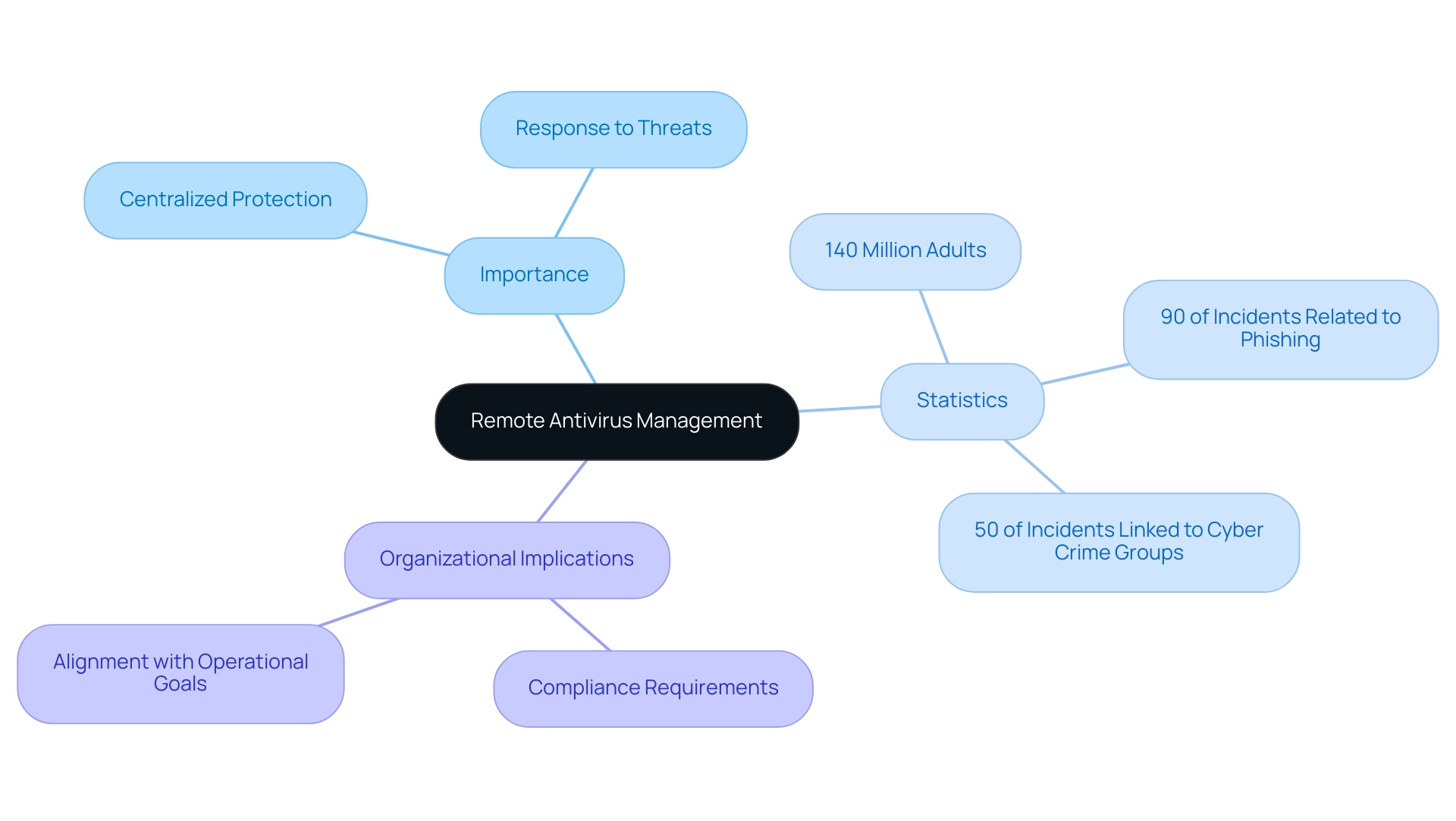
Implementing Remote Antivirus Solutions: Tools and Strategies
For entities aiming to implement effective remote antivirus management, utilizing centralized control platforms is crucial for streamlined deployment and monitoring. Tools such as:
- Microsoft Endpoint Manager
- Symantec Endpoint Protection
- Bitdefender GravityZone
offer robust features that cater to the complexities of remote antivirus management. For instance, during our tests, when we tried to download a fake computer virus using the Microsoft Edge browser, the Cisco agent immediately detected it and blocked the download, showcasing the effectiveness of these centralized tools in real-world scenarios.
Begin by conducting a thorough assessment of your organization's specific security needs and selecting tools that align closely with your objectives. With 140 million adults browsing the internet with minimal protection, the urgency of implementing strong security solutions cannot be overstated. Effective deployment strategies might include:
- Phased rollouts that prioritize critical endpoints
- Regular training sessions to elevate staff awareness regarding best practices in cybersecurity
Furthermore, incorporating automated updates and alerts significantly enhances response times to emerging threats, ensuring that your security software remains proactive and up-to-date in the face of evolving cyber risks. Additionally, while McAfee AntiVirus is designed for single Windows PC protection and has received near-perfect scores in independent lab tests, it lacks volume discounts for multiple licenses. This renders it a strong option for users requiring solid defense for a single device, enhancing the conversation on tool selection for remote security.
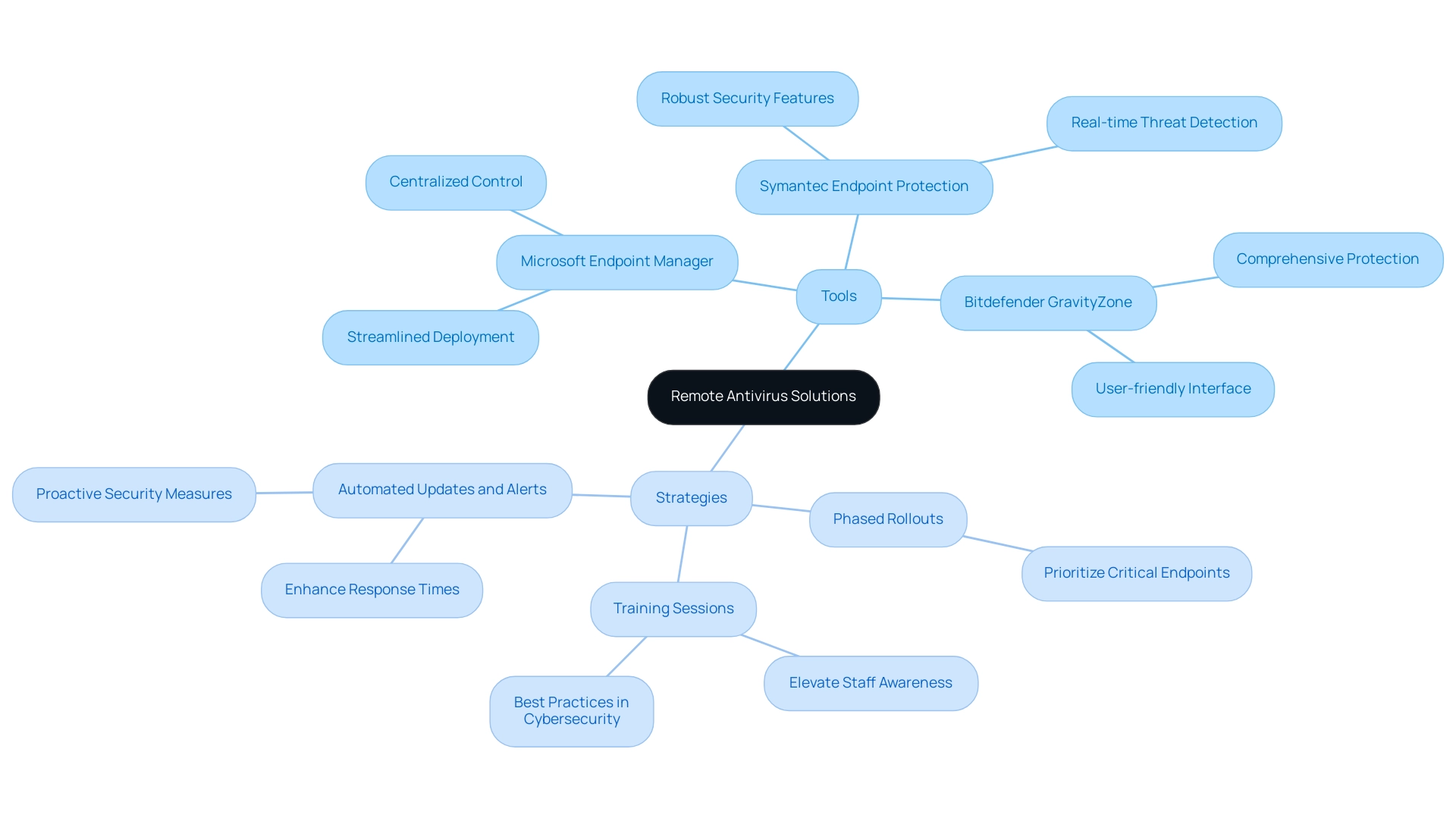
Ensuring Security in Remote Antivirus Management
To establish strong protection in remote antivirus management, organizations must prioritize implementing secure connection protocols like Virtual Private Networks (VPNs) or encrypted channels to safeguard data during transmission. Significantly, VPN usage motivation for privacy in the U.S. reached 63 percent in 2023, emphasizing the increasing acknowledgment of VPNs as essential instruments for protection. As the VPN market develops in 2023-2024, it is essential to utilize improved protective features provided by contemporary VPN solutions, which are increasingly subject to regulation.
While these solutions can reduce internet speeds by approximately 10%, a factor that can influence performance, the benefits often outweigh the drawbacks. Furthermore, adopting multi-factor authentication (MFA) for access to management consoles is essential. Research indicates that MFA can significantly mitigate the risk of unauthorized access, thus enhancing overall safety.
Regular audits and vulnerability assessments should be conducted to identify and remediate potential weaknesses within the system. Moreover, possessing a comprehensive incident response plan is essential, enabling entities to swiftly tackle any breaches or security incidents, thus reducing potential damage and ensuring continuity of operations. The differing rates of VPN adoption among nations, including Qatar's 69.87% and the UAE's 61.7%, highlight the significance of comprehending regional variations in VPN usage and their effects on entities functioning in diverse markets.
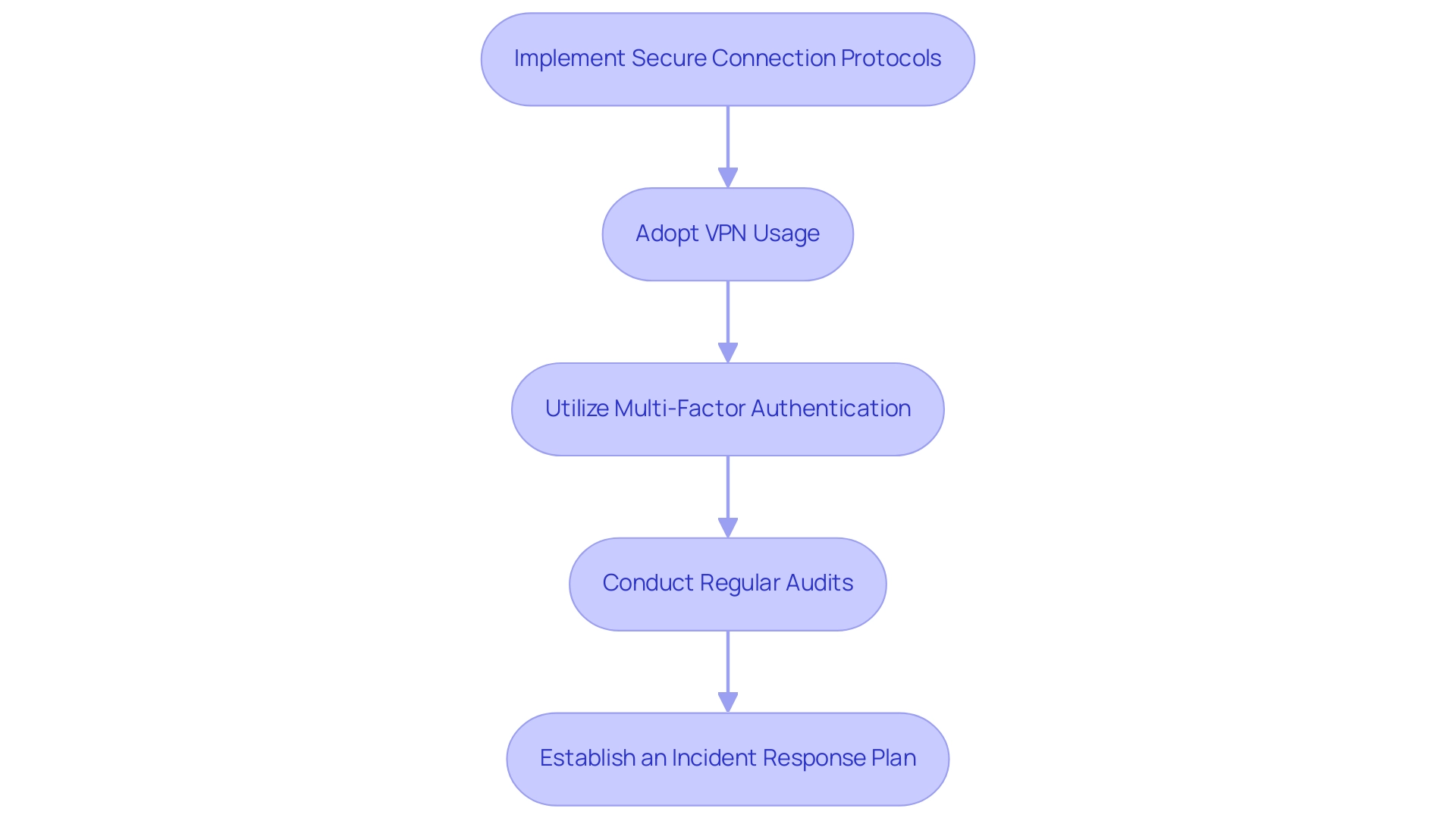
Benefits of Remote Antivirus Management Tools
Remote antivirus management tools provide numerous benefits that greatly improve operational efficiency and offer centralized control, which is vital for contemporary IT infrastructures. By allowing IT teams to utilize remote antivirus management for malware protection solutions, companies can simplify updates and implement protection policies across all devices without requiring physical access. This capability not only conserves valuable time but also minimizes the risk of human error—a crucial factor in maintaining robust cybersecurity.
Moreover, these tools enable the swift enhancement of security protocols in reaction to changing business needs, such as remote antivirus management for onboarding new staff or adjusting to a more remote workforce. The immediate surveillance and response abilities provided by remote antivirus management further strengthen a company's overall security stance. For instance, a recent analysis revealed that entities investing in Managed Detection and Response (MDR) services achieved a remarkable 50% reduction in both Mean Time to Detect (MTTD) and Mean Time to Respond (MTTR).
This statistic highlights how centralized oversight through remote antivirus management can directly enhance operational efficiency and responsiveness to threats. Furthermore, the education sector illustrates the essential requirement for such tools; it ranks lowest in cybersecurity readiness, with 87% of institutions facing at least one successful cyber attack. Social engineering tactics account for 41% of these incidents, leading to significant data breaches that compromise millions of personal records and tarnish institutional reputations.
A notable example of the consequences of inadequate cybersecurity measures is the breach of Target's point of sale systems in 2013, which compromised information of approximately 110 million customers. In this context, remote antivirus management tools emerge as a crucial element of any comprehensive IT strategy, ensuring that organizations not only safeguard sensitive data but also uphold operational efficiency in an ever-evolving threat landscape. As Tajammul Pangarkar, CMO at Prudour Pvt Ltd, aptly states, 'When he’s not ruminating about various happenings in the tech world, he can usually be found indulging in his next favorite interest - table tennis.'
This highlights the multifaceted interests of IT professionals, who must balance their technical responsibilities with personal pursuits.
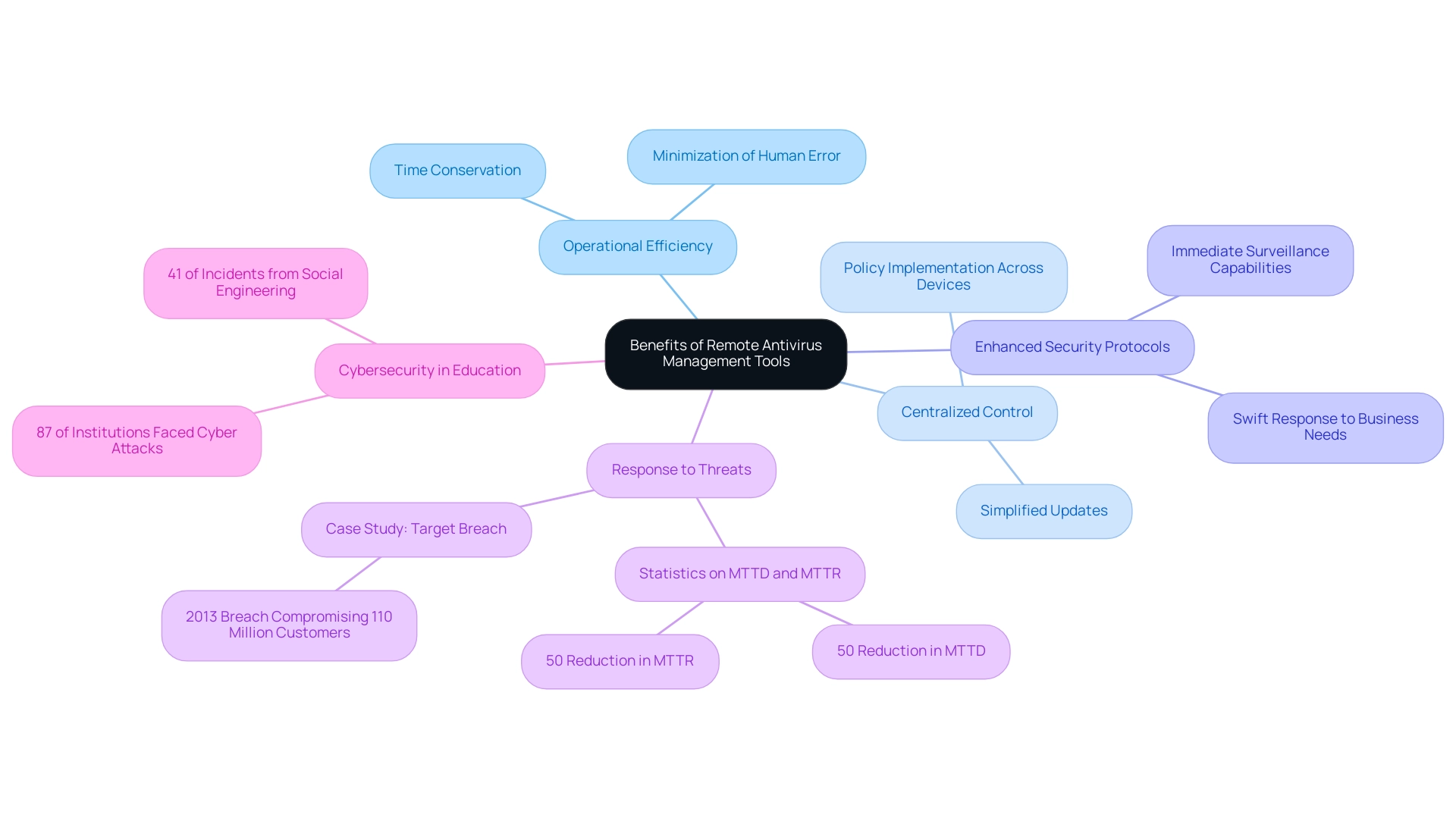
Troubleshooting and Support in Remote Antivirus Management
Effective troubleshooting in remote antivirus management is critical for maintaining robust security protocols, particularly because 92% of remote and hybrid workers use personal devices for work, which significantly increases security vulnerabilities and the risk of accidental data leakage. The Bureau of Labor Statistics notes that computer programmer job positions in the U.S. are expected to decline by 11 percent between 2022 and 2032, highlighting the need for cybersecurity professionals as the landscape evolves. Recognizing common issues such as software conflicts, update failures, and connectivity problems is essential for a proactive approach.
Establishing a centralized support system enables users to report issues efficiently and receive timely assistance, minimizing downtime. Creating a thorough knowledge base that encompasses FAQs, troubleshooting guides, and instructional videos enables users to address minor problems on their own, thereby lowering the total number of support requests. Furthermore, regular training sessions improve user familiarity with security tools and procedures, further reducing the occurrence of typical troubleshooting issues.
Utilizing analytics from security management tools can offer valuable insights into recurring issues, facilitating proactive adjustments and enhancements to the system. This method is particularly relevant considering the media, leisure, and entertainment sector, where 60% of entities reported ransomware incidents, highlighting the need for efficient protective software. Additionally, as supported by OxLEP, business resilience is increasingly critical in the face of evolving cyber threats.
By adopting these strategies, organizations can reinforce their defenses against the evolving landscape of cyber threats, ensuring business resilience and continuity.
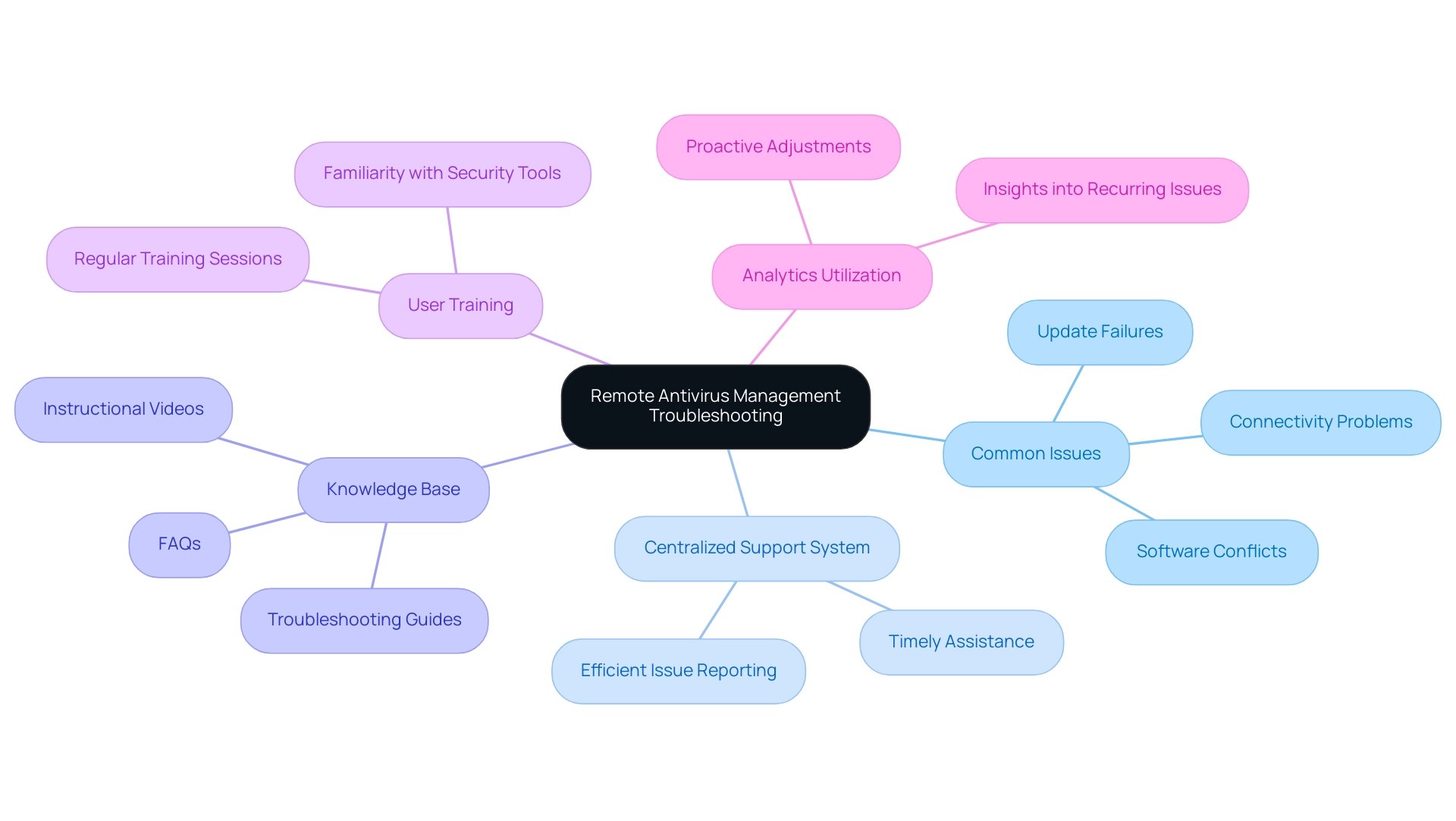
Future Trends in Remote Antivirus Management
The cybersecurity landscape is rapidly evolving, and several pivotal trends are shaping the future of remote antivirus management. Key among these is the integration of Artificial Intelligence (AI) and Machine Learning (ML) into security solutions, enhancing their threat detection and response capabilities. These advanced technologies enable the analysis of vast datasets, allowing for the swift identification of anomalies and potential threats—far more efficiently than traditional methods.
As entities grapple with increasing cybersecurity threats, the significance of these capabilities cannot be overstated.
Moreover, the shift toward cloud-based solutions is gaining momentum, particularly in the area of remote antivirus management, driven by the industry's current valuation of approximately $4 billion. This statistic highlights the urgency for entities to adopt scalable and flexible protective measures in real-time, ensuring strong defense against emerging threats. Businesses are increasingly seeking dynamic solutions for remote antivirus management that can adapt to the evolving landscape of cybersecurity. Additionally, organizations must prepare for an anticipated rise in regulatory compliance requirements.
With 93% of leaders in the field anticipating daily AI assaults by 2025, including prevalent dangers such as phishing, online attacks, and credential theft, the necessity for thorough reporting and monitoring features in malware protection tools grows increasingly vital. Gigaom has acknowledged companies such as Cobalt as “Outperformers” for their innovative strategies in this area, emphasizing the importance of staying informed about these trends to sustain a proactive stance. Adopting AI-driven tools in antivirus management not only enhances security measures but also builds consumer trust through responsible AI practices, ensuring that systems remain non-biased, transparent, and fair.
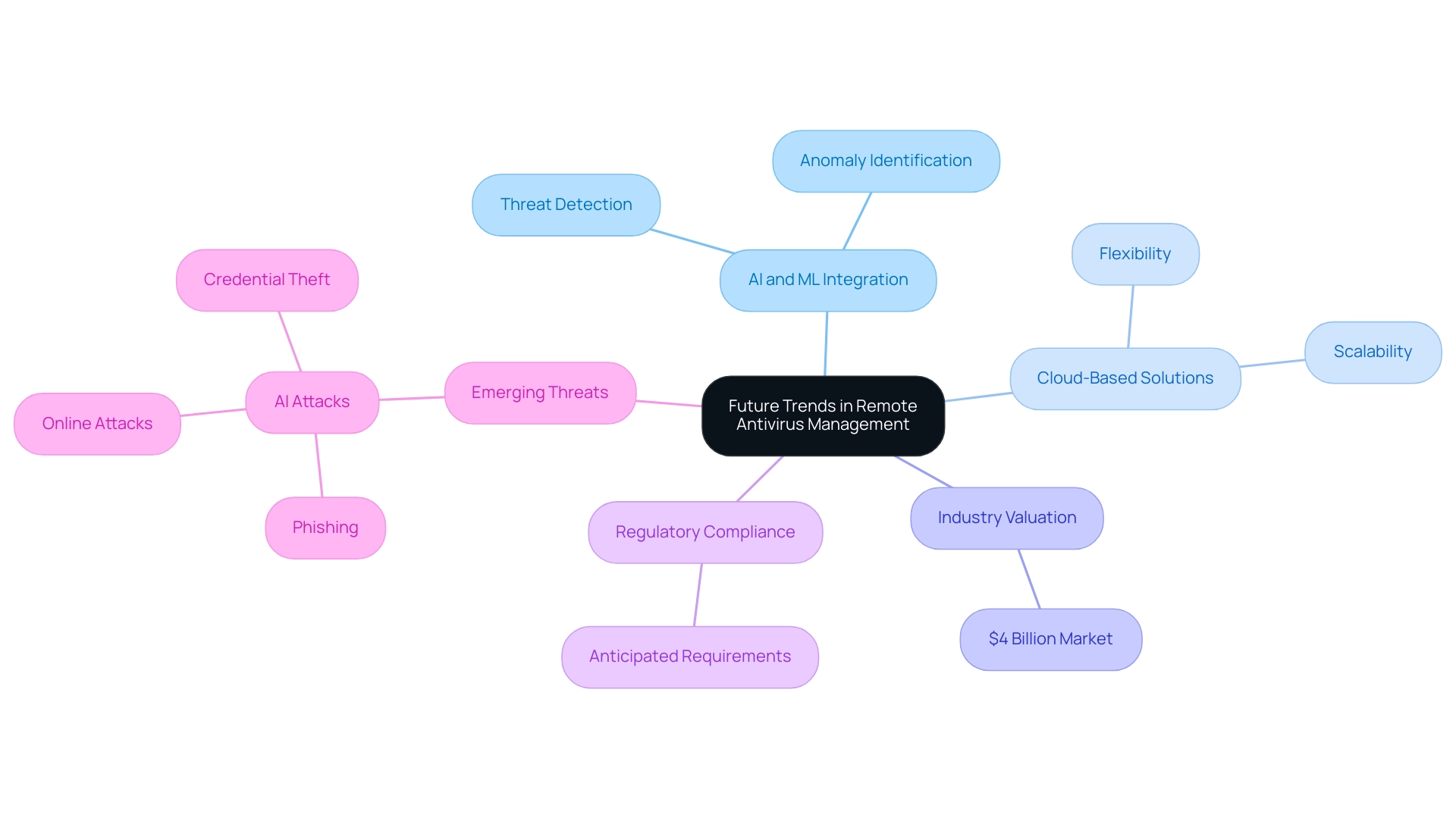
Conclusion
The insights presented throughout this article underscore the critical role of remote antivirus management in today’s digital landscape. As organizations transition to remote work models, the necessity for robust cybersecurity measures, including centralized antivirus management, becomes paramount. By leveraging advanced tools and strategies, businesses can effectively protect their sensitive data against an array of sophisticated cyber threats while ensuring compliance with evolving regulations.
Implementing effective remote antivirus solutions involves not only selecting the right tools but also adopting comprehensive strategies that prioritize security and efficiency. Organizations are encouraged to:
- Conduct thorough assessments
- Utilize centralized platforms
- Foster a culture of cybersecurity awareness among employees
The benefits of these practices are clear:
- Enhanced operational efficiency
- Reduced response times to threats
- Strengthened overall security posture
Looking to the future, the integration of Artificial Intelligence and Machine Learning in antivirus management is set to revolutionize threat detection and response. As organizations prepare for an increase in regulatory requirements and cyber threats, staying informed about emerging trends and adopting innovative solutions will be vital. Ultimately, a proactive approach to remote antivirus management will empower organizations to navigate the complexities of the cybersecurity landscape with confidence, safeguarding their assets and ensuring business continuity.




